History of Tattoos: From Otzi The Iceman to Sailor Jerry
The history of the tattoo is a rich and interesting one. When I was working on the book, Let's Be Realistic, with Mike DeVries, I studied the topic of tattoo history in depth. I have compiled a brief summary of many key points regarding the timeline of body art, from the Stone Age through the 1960s. The history of the tattoo continues each day and with every inked design that is added to the skin canvas. I wonder how tattoos as we know them now will be viewed a century from now?
Tattoo History: Stone Age to the 60s
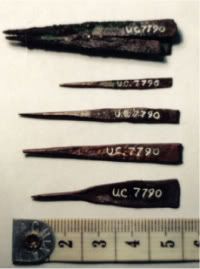 Small bronze tattooing implements (c. 1450 B.C.) from Gurob, Egypt, can be found at the Petrie Museum of Egyptian Archaeology in London.Tattooing has been around since the Neolithic/Stone Age period. In 1991, Otzi the Iceman, a five thousand year old tattooed man, was found in the Otz Valley in the Alps and bore 57 tattoos on his skin. Lines in his skin were 15 centimeters long above his kidneys and numerous parallel lines on the ankles; as well as a cross on the inside of his knee. The position of the tattoos showed that they may have been applied for therapeutic reasons, perhaps for arthritis.
Small bronze tattooing implements (c. 1450 B.C.) from Gurob, Egypt, can be found at the Petrie Museum of Egyptian Archaeology in London.Tattooing has been around since the Neolithic/Stone Age period. In 1991, Otzi the Iceman, a five thousand year old tattooed man, was found in the Otz Valley in the Alps and bore 57 tattoos on his skin. Lines in his skin were 15 centimeters long above his kidneys and numerous parallel lines on the ankles; as well as a cross on the inside of his knee. The position of the tattoos showed that they may have been applied for therapeutic reasons, perhaps for arthritis.
- During the Upper Paleolithic period, it is believed that people used instruments that looked like a disc of clay and bone needles that were very sharp. They would put needles into the holes at the top of the disc and then with the pigment (red ochre) the needles would poke the skin.
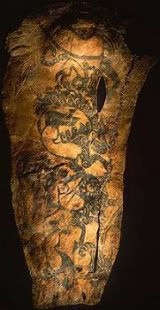 A tattoo on the right arm of a Scythian chieftain whose mummy was discovered at Pazyryk, Russia.In 1891, archaeologists found mummified remains of a priestess, thought to have lived around 2000 B.C., who possessed many geometric and schematic patterns on her body. Pazyryk mummies were found in the High Altai Mountains of western and southern Siberia and date back 2400 years ago. Many of the tattoos discovered on the bodies of these mummies symbolized animals that were common during that time period.
A tattoo on the right arm of a Scythian chieftain whose mummy was discovered at Pazyryk, Russia.In 1891, archaeologists found mummified remains of a priestess, thought to have lived around 2000 B.C., who possessed many geometric and schematic patterns on her body. Pazyryk mummies were found in the High Altai Mountains of western and southern Siberia and date back 2400 years ago. Many of the tattoos discovered on the bodies of these mummies symbolized animals that were common during that time period.
- The practice of tattooing has had immense historical significance in Polynesian cultures, where it is believed that a person’s spiritual life force, or mana, is displayed through their tattoos. The Maori in New Zealand believe that the moko, or tattoo, reflects their artistic erudition; the full-face moko being a sign of prestige and superiority of status. In Samoa, tattooing by hand is associated with rank, title and prestige, and there are tattoo ceremonies at the onset of puberty that celebrate young chiefs’ perseverance, endurance and dedication to their cultural heritage and tradition.
 Maori tattoo
Maori tattoo
- The Hawaiian culture's traditional tattoo art is known as kakau. It is said to protect the wearer's spiritual well-being and health, as well as offers distinction and ornamental beauty. Many men wear detailed patterns that are shaped from natural forms and designs and can be seen on legs, arms, torsos and faces. Women are often tattooed on fingers, wrists, and hands.
- Some believe that the origin of the word “tattoo” comes from “tatau,” the Samoan word meaning, “to mark twice.” “Ta,” means “hand” and is duplicated because of the repetitive action involved; while the “u” refers to “color.” Captain James Cook, a British explorer, introduced the Western world to this phenomenon, when he recorded information about the word in a diary passage in the late 1760s. He wrote, “they print signs on people’s bodies and call this tattaw.” He again visited the subject in 1779, when he stated that “the universality of tattooing is a curious subject for speculation.” Several members of Captain Cook’s crew would regularly return to England with tattoos, a practice that eventually drew an association between tattoos and sailors; as they collected artwork on their skin from their various voyages.
Tattooing in Japan has a long and brilliant history. During the 18th century, in the Edo period, traditional Japanese tattoos, known as horimono, began to emerge as a beautiful art form. It utilized images from woodcuttings and traditional water color paintings. Some of the earliest artists were ukiyoe woodblock artists and traded in their woodcarving tools for long, pointy needles and skin canvases. As the art form became more concentrated, these artists began devoting their time and efforts into specializing in this unique style of tattooing, centering many of the tattoo themes around ancient folklore that involved: fire, wind, water, snakes, tigers, lions, dragons, waves, kois, samurai warriors, water and flowers. Traditional Japanese tattooing involves using a set of needles that are attached to the end of a wood or metal handle and the ink is pushed in manually. This age-old form of tattooing is still practiced today by a handful of widely-respected Japanese master tattooists, whose rich history has had a positive influence on tattoo collectors and artists in Western culture.
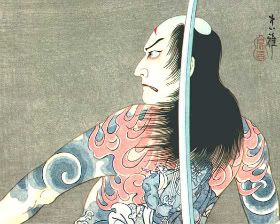
- Clay figures found in Japan, dating back to 3,000 BC or older, have been found with painted faces or engravings that look like tattoo marks and are believed to have represented stand-ins for living people who symbolically accompanied the dead in their concept of the afterworld. The tattoo marks are said to have "magical and religious" significance. In Japanese, a "horishi" is a tattoo artist. The prefix of "hori" (meaning: "to carve") was first given as a title in the late 1800s. The titles were often tattooed on a client as the signature from the artists. These tattooists eventually formed master-apprentice associations, as an accomplished master would prepare students, title them and then eventually pass on his name to that pupil. For example, Horiyoshi I, from Yokohama, gave his brother the title of Horiyoshi II and then chose to give his student, Yoshihito Nakano, the title of Horiyoshi III. This succession lasted through fifty years and Horiyoshi III's son, Nakano Kazuyoshi, is learning the craft and will in due time be given the title of Horiyoshi IV. Horiyoshi III was born in 1946 and for over thirty years has been the pre-eminent authority on Japanese tattooing. He received his full body-suit at the age of 28 and it was completely hand-tattooed by his master. Horiyoshi III is still a full-time tattoo artist, has written several books and owns a tattoo museum in Japan with his wife. He is admired and respected throughout the modern day tattoo community, for both his amazing tattoo work and his loyalty to tradition and strict cultural discipline.
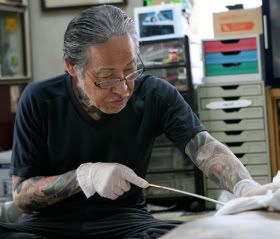 Horiyoshi III
Horiyoshi III
- The Persians are said to have taught the Greek culture about the art of tattooing, while in turn, Romans adopted tattooing from the Greeks. Roman writers like Seneca, Galenus and Virgil all wrote of criminals and slaves that were tattooed. During the Early Roman Empire, the slaves exported to Asia were tattooed with the words, "tax paid" on their skin. When Constantine became the Roman Emperor in the 4th century and rescinded the Christianity prohibition, he banned tattoos on the face, of which some gladiators and soldiers wore, because he said that the face was a representation of god and it should not be defiled.
- Native Americans in North America were oftentimes recognized by their tattoos. Warriors in the Chickasaw tribe wore them; as did the Ontario Iroquoians, whose tattoos reflected their status. In Northwest America, Inuit women wore tattoos on their chins to indicate marital status.
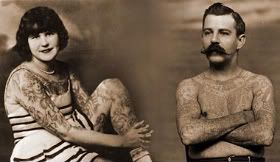 Tattoos were popular with circus performers in the late nineteenth century and the first half of the twentieth century, as most major traveling circus troupes hired heavily tattooed people who were exhibited in sideshows.
Tattoos were popular with circus performers in the late nineteenth century and the first half of the twentieth century, as most major traveling circus troupes hired heavily tattooed people who were exhibited in sideshows.
- In 1891, the first electric tattoo machine was invented and patented by tattoo artist, Samuel O’Reilly. He discovered a device called the "Electric Pen" which was invented by Thomas A. Edison in 1876. The Electric Pen was part of a document duplication system used by businesses and used a high-speed reciprocating motor to drive a single needle. It did not use any ink, rather, perforated holes in a master form, of which then became a stencil. Ink rolled onto its surface and passed through the holes to make copies onto blank sheets placed underneath the stencil. O'Reilly took this invention, added multiple needles and an ink reservoir, and earned a U.S. patent. This revolutionary device was extremely innovative in opening the door to a whole new generation of growth in the tattoo realm. This development would eventually lead to further advances in various areas, including: pigments/inks, needles, sterilization methods, designs/flash, as well as the tattoo culture in general.

- In addition to O’Reilly’s contribution to Western culture’s tattoo history, one of the foremost American tattoo artists of his time was Norman “Sailor Jerry” Collins. He was born in 1911 and died
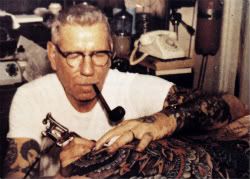 Sailor Jerryat the age of 62, in 1973. During his lifetime, Sailor Jerry created needle formations that were able to embed pigment with significantly less trauma to the skin than had been previously seen. He also developed his own safe pigment inks that came in a multitude of colors that the industry had not seen or used until that time. Furthermore, Collins was one of the first artists to use single-use needles and to offer high quality sterilization methods in his shop. Sailor Jerry was known for the accurate details and well-defined precision in his work, much of which focused around nautical themes and designs. His first shop was in Chinatown in Honolulu, Hawaii, and Sailor Jerry became a mentor to two other artists who went onto become legends in their own rights: Don Ed Hardy and Mike Malone aka Rollo.
Sailor Jerryat the age of 62, in 1973. During his lifetime, Sailor Jerry created needle formations that were able to embed pigment with significantly less trauma to the skin than had been previously seen. He also developed his own safe pigment inks that came in a multitude of colors that the industry had not seen or used until that time. Furthermore, Collins was one of the first artists to use single-use needles and to offer high quality sterilization methods in his shop. Sailor Jerry was known for the accurate details and well-defined precision in his work, much of which focused around nautical themes and designs. His first shop was in Chinatown in Honolulu, Hawaii, and Sailor Jerry became a mentor to two other artists who went onto become legends in their own rights: Don Ed Hardy and Mike Malone aka Rollo.
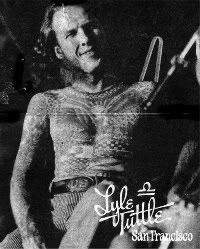 Lyle TuttleHardy is well-known for incorporating Japanese tattoo design and technique into his artwork; and also for revolutionizing tattoo art into the pop culture scene. He has been very successful overseeing many art gallery exhibitions and frequently lectures at colleges and museums. Another influential artist during the 1960's was Lyle Tuttle, who was making headlines in the tattoo world, with his legendary work that he did on women’s skin. When asked what made tattooing gain in popularity during his early career, he is quoted in Prick Magazine as saying, “Women's liberation! One hundred percent women's liberation! That put tattooing back on the map. With women getting a new found freedom, they could get tattooed if they so desired."
Lyle TuttleHardy is well-known for incorporating Japanese tattoo design and technique into his artwork; and also for revolutionizing tattoo art into the pop culture scene. He has been very successful overseeing many art gallery exhibitions and frequently lectures at colleges and museums. Another influential artist during the 1960's was Lyle Tuttle, who was making headlines in the tattoo world, with his legendary work that he did on women’s skin. When asked what made tattooing gain in popularity during his early career, he is quoted in Prick Magazine as saying, “Women's liberation! One hundred percent women's liberation! That put tattooing back on the map. With women getting a new found freedom, they could get tattooed if they so desired."
As Charles Darwin once said about tattoos, “There is no nation on earth that does not know this phenomenon.”
Happy Tattooing! Keep on making history by inking your own personal story upon your epidermal canvas.
**This post can also be found in the Tattoo Corner for easy future reference
 Friday, October 9, 2009 at 9:22AM | |
Friday, October 9, 2009 at 9:22AM | |  Email Article
Email Article 


Reader Comments (7)
I loved this post. Thank you.
Awesome, Jinxi!!
You forgot to mention Otzi the Iceman also had "Thug Life" across his abdomen. And 2Pac thought he was original!
This post has fed my brain and my obsession with cultural anthropology. I love the history of things and people. Why we do what we do. You make me being a nerd both rewarding and cool. Thanks so much for all the great info.
I have big plans for my next tattoos, all I need is the money, and my visual story will continue.
Thanks for the great info!
Do you think anyone who was around that Scythian chieftain said "wait till you get old and saggy"?? Don't you just love when people say that to you? I laugh at them. lol.
I won't say anything about Hardy's high end clothing line...cough cough. I'll leave that to Garfunkel and Oates. ;-)
http://garfunkelandoates.com/music/clips/11/this-party-took-a-turn-for-the-douche/
This was really interesting Jinxi! I can't wait to share it with Sam :)! xoxo
Wow…replica iwc|
Thanks for compiling this and posting it.
Raspekt from Chi-town.
we provide you the best and most fashionable products. All the products are 100% high quality, competitive price, free shipping with best and timely service, 100% satisfaction. Big discount for big order. Welcome to make your choose.Enjoy your shopping!
sex pills factory
sex pills wholesale
buy wholesale
Wholesale Supplier
Sex Pills Supplier
Sex Pills Wholesale Supplier
louis vuitton
lv
louis vuitton wallets
louis vuitton purses
louis vuitton sunglasses
louis vuitton bags
louis vuitton handbags
lv
louis vuitton bags
louis vuitton
lv
louis vuitton wallets
louis vuitton purses
louis vuitton sunglasses
louis vuitton bags
louis vuitton handbags
lv
louis vuitton bags
louis vuitton
lv
louis vuitton wallets
louis vuitton purses
louis vuitton sunglasses
louis vuitton shoes
louis vuitton bags
louis vuitton handbags
lv
louis vuitton bags
christian louboutin
louboutin
christian louboutin shoes
louboutin shoes
bridal shoes
sexy shoes
high heels shoes
ugg discount boots
cheap ugg boots
ugg boots cheap
discount uggs boots
ugg cardy boots
discount uggs
discounted ugg boots
cheap uggs boots
uggs for cheap
ugg
ugg boots
ugg shoes
ugg tall boots
ugg short boots
ugg boots sale
ugg boots on sale
ugg boots on cheap
ugg discount
uggs
discount uggs
ugg sale
ugg kids
ugg women
cheap ugg
ugg discount boots
cheap ugg boots
ugg boots cheap
discount uggs boots
ugg cardy boots
discount uggs
discounted ugg boots
cheap uggs boots
uggs for cheap
ugg
ugg boots
ugg shoes
ugg tall boots
ugg short boots
ugg boots sale
ugg boots on sale
ugg boots on cheap
ugg discount
discount ugg
uggs
discount uggs
ugg sale
ugg kids
ugg women
cheap ugg
ugg discount boots
cheap ugg boots
ugg boots cheap
discount uggs boots
ugg cardy boots
discount uggs
discounted ugg boots
cheap uggs boots
uggs for cheap
ugg tall boots
ugg short boots
ugg boots sale
ugg boots on sale
ugg boots on cheap
ugg discount
discount ugg
discount uggs
ugg sale
ugg kids
ugg women
cheap ugg
ugg discount boots
cheap ugg boots
ugg boots cheap
discount uggs boots
ugg cardy boots
discount uggs
discounted ugg boots
cheap uggs boots
uggs for cheap
ugg tall boots
ugg short boots
ugg boots sale
ugg boots on sale
ugg boots on cheap
ugg discount
discount ugg
discount uggs
ugg sale
ugg kids
ugg women
cheap ugg
ugg discount boots
cheap ugg boots
ugg boots cheap
discount uggs boots
ugg cardy boots
discount uggs
discounted ugg boots
cheap uggs boots
uggs for cheap
ugg tall boots
ugg short boots
ugg boots sale
ugg boots on sale
ugg boots on cheap
ugg discount
discount ugg
discount uggs
ugg sale
ugg kids
ugg women
cheap ugg
ugg discount boots
cheap ugg boots
ugg boots cheap
discount uggs boots
ugg cardy boots
discount uggs
discounted ugg boots
cheap uggs boots
uggs for cheap
ugg tall boots
ugg short boots
ugg boots sale
ugg boots on sale
ugg boots on cheap
ugg discount
discount ugg
discount uggs
ugg sale
ugg kids
ugg women
cheap ugg
christian louboutin
louboutin
christian louboutin shoes
louboutin shoes
bridal shoes
sexy shoes
high heels shoes
christian louboutin
louboutin
christian louboutin shoes
louboutin shoes
bridal shoes
sexy shoes
high heels shoes
christian louboutin
louboutin
christian louboutin shoes
louboutin shoes
bridal shoes
sexy shoes
high heels shoes
christian louboutin
louboutin
christian louboutin shoes
louboutin shoes
bridal shoes
sexy shoes
high heels shoes
christian louboutin
louboutin
christian louboutin shoes
louboutin shoes
bridal shoes
sexy shoes
high heels shoes